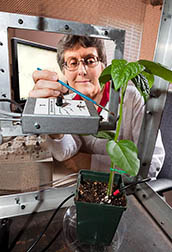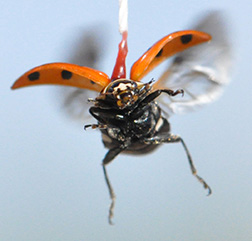 ARS entomologist Elaine Backus adjusts the position of an insect connected to an electrical probe to study how it feeds and transmits diseases to plants. Photo: Steve Ausmus/ARS. |
 A lady beetle’s flight behavior is studied in an ARS "flight mill." Photo: Scott Machtley/ARS. |
ARS Entomologists Publish Guides on Latest Research Tools
By Dennis O'Brien
May 2, 2019
Entomologists have developed a variety of tools to study insects.
They have flight mills where insects are tethered to a rotating arm, so they can monitor the insect’s flight speed and duration. They've developed specialized techniques for marking insects with proteins to track their movements, diets and feeding patterns. There are state-of-the-art video cameras and accompanying software for continuously monitoring insects, for weeks at a time, in laboratories. Researchers can attach electrical probes to insects to learn how they feed on plants and transmit diseases.
But how would an entomologist just starting out, or one who wants to broaden the scope of their research, know what tools are available? How would they know, for instance, what software to use to analyze video of a caged insect recorded over a two-week stretch so they could better understand the nuances of its behaviors and life cycle?
The answers are covered in a special collection of review articles put together by five ARS entomologists this month in the Annals of the Entomological Society of America, the journal published by the ESA.
The papers offer a little bit of everything for entomologists interested in becoming familiar with the latest tools. They are the result of a symposium at an Entomological Society of America conference in 2017 where researchers were given 15 minutes to describe their tools and they agreed to write explanatory review papers to more thoroughly cover their topics.
"Some of these tools are relatively new and to someone unfamiliar with them they can seem highly specialized. But as they come down in cost and become more widely available, more scientists are interested in using them and they should be able to tap into their potential," says Jana C. Lee, an ARS entomologist in Corvallis, Oregon, who searches for ways to manage insect pests in small fruits and nursery crops.
Lee's introductory article and the papers are available online.
The Agricultural Research Service is the U.S. Department of Agriculture's chief scientific in-house research agency. Daily, ARS focuses on solutions to agricultural problems affecting America. Each dollar invested in agricultural research results in $20 of economic impact.
